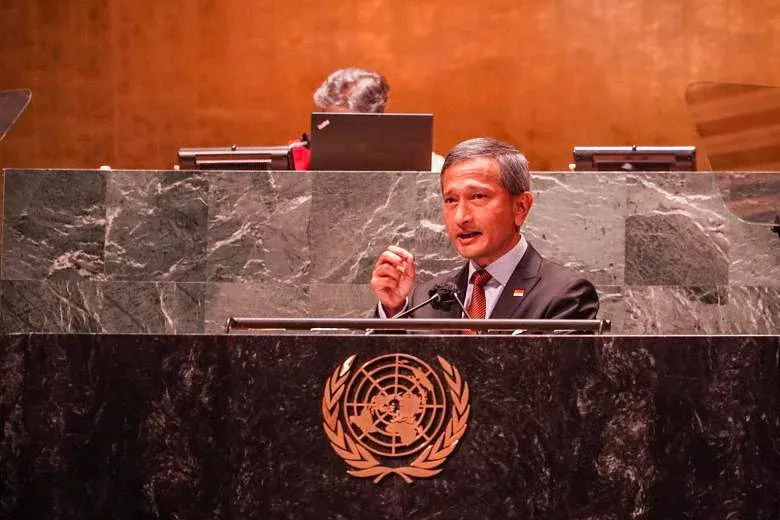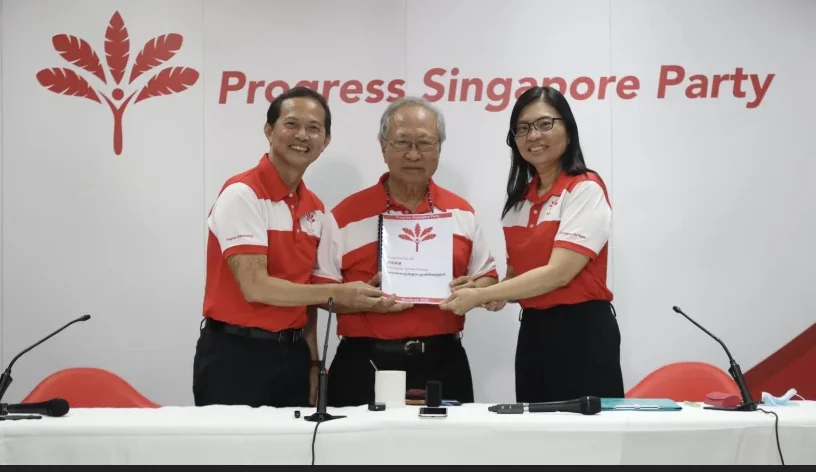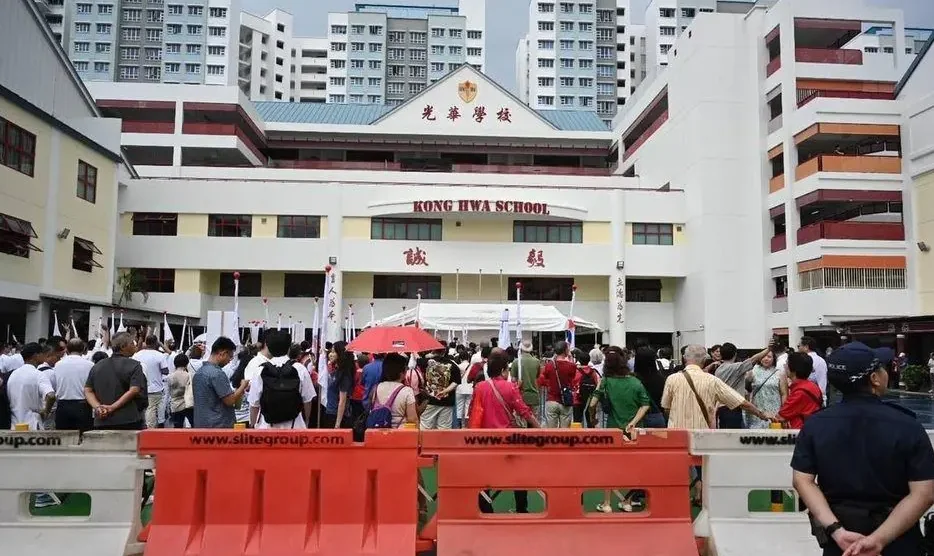菲俄表态后,新加坡外长在联大公开强调:台海是中国红线
值得一提的是,菲律宾和新加坡这两个东南亚国家在联合国大会就台海问题发声,也间接证明了,大部分东南亚国家对台海爆发冲突一事感到焦虑。

值得一提的是,菲律宾和新加坡这两个东南亚国家在联合国大会就台海问题发声,也间接证明了,大部分东南亚国家对台海爆发冲突一事感到焦虑。

Dr Tan called PM Wong's statement on the US tariffs as a fear-mongering but later admitted that it's a very serious problem.

During the PSP's manifesto launch early this month (Apr 6), Dr Tan Cheng Bock, the party's chairman, criticized the government's response to the US tariffs as "overblown".
He suggested that the government's strong warnings, such as Prime Minister Lawrence Wong's (PM Wong) statement on about the "likelihood of a full-blown global trade war," might be an attempt to "instil fear" in voters to make them choose the incumbent as a "safe bet" ahead of the General Election.
In a YouTube video, PM Wong urged Singaporeans to brace themselves because the risks are real and the stakes high.
Dr Tan called for economists to study the real impact of the tariffs. "Don't just make statements of this kind and scare everybody," he said.
On Saturday (Apr 19), Dr Tan reiterated his party’s stance on the trade war, calling it “a very difficult problem, but a very serious problem” that “we are not taking lightly”.
He said: "Trump is so unpredictable. I cannot give you the answer also. But i don't think that we are just lying low and say oh, nothing to worry. of course, we worry differently. We are looking for answers. This is a very difficult, serious problem. And we are not taking it lightly."
PSP's position on the US tariffs reflects a critical view of the government's initial response as potentially exaggerated for political gain but later recognized the trade war's significant economic implications that should not be taken lightly.
China aims to dominate ASEAN by leveraging Singapore’s diplomatic influence and cultural ties, while Israel seeks to preserve its strategic alliance with Singapore - one of very few countries still allied with Israel in ASEAN.

Disclaimer: This analysis is a speculative exploration based on geopolitical trends, historical patterns, and open-source intelligence.
Foreign interference isn’t a conspiracy theory; it’s a global reality, from Russia’s 2016 U.S. election hacks to China’s whispered influence in Australia.
Singapore, a tiny island with outsized influence, is a high-value target. Its role as a global financial hub, with approximately S$5.4 trillion in assets under management makes its electoral outcome a matter of international consequence.
China, Singapore’s largest trading partner with S$150 billion in bilateral trade in 2022, has strong incentives to influence GE2025.
As ASEAN’s diplomatic anchor, Singapore influences regional policies critical to China’s Belt and Road Initiative and South China Sea claims.
A government aligned with Beijing would enhance its dominance in Southeast Asia, where Singapore’s neutrality is a linchpin.
Moreover, Singapore’s military training partnerships with Taiwan make it a target for China’s efforts to suppress Taiwanese independence narratives.
Past disinformation campaigns
China has a well-documented history of disinformation:
Taiwan: Beijing has used deepfakes and propaganda to discredit Taiwanese leaders and deter voters from supporting independence, targeting Chinese-speaking communities to sow division, as reported by regional security experts.
Philippines: China has promoted narratives portraying itself as a constructive regional actor while casting doubt on U.S. reliability, aiming to weaken U.S.-Philippine ties, per the Center for Strategic and International Studies.
Singapore (2017): A notable incident involved Huang Jing, a U.S. citizen and academic at the Lee Kuan Yew School of Public Policy, who was expelled in August 2017 for acting as an agent of influence for a foreign country, widely understood to be China. Huang used his position to share privileged information with foreign intelligence operatives and attempted to influence Singapore’s foreign policy, per MHA.
Potential impact in Singapore
Singapore’s 74% ethnic Chinese population and economic ties with China create vulnerabilities to disinformation.
AI-generated deepfakes on platforms like Meta and Tiktok could depict candidates disparaging Chinese culture, alienating voters.
Cyber operations might target journalists of alternative and mainstream media outlets, while covert funding through Chinese business networks or clan associations could support pro-China candidates.
The October 2024 deepfake video targeting former President Halimah Yacob, falsely showing her criticizing the government, underscores this threat.
The 2020 case of Dickson Yeo, a Singaporean sentenced in the U.S. for spying for Chinese intelligence, further highlights Beijing’s use of local operatives, though Yeo claimed no disloyalty to Singapore.
Why Singapore?
Singapore’s diplomatic leadership in ASEAN and military ties with Taiwan make it a strategic target.
China’s ambition to dominate ASEAN relies on influencing key players like Singapore, whose neutral stance could shift regional dynamics if manipulated.
Disinformation could erode public trust or promote candidates aligned with Beijing’s goals.
Israel, a key defense partner supplying Singapore with technologies like the Iron Dome, seeks to maintain a government supportive of bilateral ties.
As one of Singapore’s few ASEAN allies alongside Thailand, and with neighbors like Malaysia and Indonesia holding anti-Israel stances, Singapore’s pro-Israel policies are crucial.
A change in government could disrupt defense cooperation or weaken Israel’s Southeast Asian foothold, where Singapore is a diplomatic and technological hub.
Past disinformation campaigns
Israel’s disinformation efforts, particularly since the Gaza war, have aimed to shape global narratives:
U.S. Lawmakers (2024): Israel funded a $2 million campaign through Stoic, a Tel Aviv-based firm, using 600 fake social media accounts to target 128 U.S. Congresspeople with pro-Israel messaging. Active as of June 2024, it employed AI tools like ChatGPT and fake news sites to attack UNRWA and influence policy (The New York Times, June 2024).
Gaza War propaganda: AI-driven bot farms spread false narratives to dehumanize Palestinians and pressure policymakers, as reported by The Intercept in February 2024 (Gaza: Israel, Netanyahu, propaganda, lies, Palestinians).
Meta censorship: Israel secured the removal of 38.8 million pro-Palestinian posts on Meta platforms by April 2025, aligning with efforts to suppress criticism (Dropsite News).
Specific falsehoods: Misleading claims, such as audio evidence in the Gaza Baptist Hospital massacre, highlight tactical disinformation (Euronews, February 2024).
Potential impact on Singapore
Israel’s cyber capabilities, exemplified by tools like Pegasus and Graphite used in Singapore pose a threat.
While the 2024 Graphite spyware from Paragon Solutions was reportedly halted, Israel’s history with Pegasus—sold to various governments—suggests that comparable tools remain active.
Disinformation campaigns might target Singapore’s Malay-Muslim community (15% of the population) to counter anti-Israel sentiments, using bots on platforms like Meta.
Covert lobbying through defense or tech partnerships could subtly influence policy.
Why Singapore?
Singapore’s status as a rare ASEAN ally makes it a linchpin for Israel’s regional strategy.
A pro-Israel government ensures sustained defense cooperation and counters regional hostility.
Disinformation could protect these ties by shaping elite perceptions or neutralizing anti-Israel narratives.
Singapore has fortified its electoral process against disinformation:
Foreign Interference (Countermeasures) Act 2021 (FICA): Enables authorities to remove false content and scrutinize foreign funding, countering China’s deepfakes and Israel’s bot campaigns Countering Foreign Interference.
Cybersecurity: The Cyber Security Agency (CSA) secures electoral systems, with 2023 advisories promoting robust digital protections Advisory to Presidential Election Candidates.
Public resilience: Media literacy campaigns and high public trust (84% in government, 2023 Edelman Trust Barometer) equip citizens to identify disinformation Commentary: What Singapore can do more against rising threat of foreign interference.
The FICA law was in the news recently when four members of one of Singapore's richest families were designated as "politically significant persons" for their membership to a China political advisory body. MHA had emphasised that the four individuals had not engaged in any “egregious activity”. As such, their designation can be seen as a pre-emptive move to guard against any potential vulnerabilities to foreign interference.
Also last year, FICA was invoked to block 95 social media accounts linked to self-exiled Chinese billionaire Guo Wengui, the first time that the account restrictions directions under FICA were being deployed.
China aims to dominate ASEAN by leveraging Singapore’s diplomatic influence and cultural ties, while Israel seeks to preserve its strategic alliance.
Singapore’s FICA, cybersecurity, and public resilience provide a strong defense, but sustained vigilance is critical.
Enhanced cyber audits, monitoring of foreign networks, and public education will ensure Singapore’s vote remains untainted.
As GE2025 approaches, the nation’s commitment to sovereignty will determine its success in countering these threats.
在全球地缘政治的风暴中,新加坡如何驾驭大国博弈?选择中立意味着在经济与安全上避免与任何一方结盟。然而,新加坡对中美两大市场的深层依赖,迫使其采取务实外交。这不是中立性的试炼——而是实力的彰显。通过在供应链、科技与外交领域砥砺锋芒,新加坡并非规避站队,而是化被动为主动,让大国竞相争取其青睐。这不是中立——这是实力。

新加坡能否在动荡的地缘政治格局中保持中立?
前贸易及工业部长、现任教育部长陈振声在新传媒播客中指出,问题不在于选择站队——有时这由不得你——而在于让新加坡变得如此不可或缺,以至于各方都想分一杯羹。
陈部长的洞见凸显了新加坡务实的外交策略,但却掩盖了一个冷峻的事实:在中美之间深厚的经济与战略纠葛面前,中立不过是一场海市蜃楼。
由于与美国和中国的经济、战略及地缘政治联系根深蒂固,新加坡在中美贸易战中无法保持真正中立。
2023年,中国占新加坡出口的14%(830亿美元),进口的13%;美国则占出口的13%(760亿美元),进口的10%。
美国的外国直接投资(2340亿美元)是新加坡经济增长的引擎,而中国的“一带一路”倡议则充分利用新加坡港口的枢纽地位,2024年处理了3700万标准箱(TEU)。
新加坡支持美国主导的印太框架,如2022年启动的“印太经济繁荣框架”(IPEF)。这一由14国(不含中国)组成的联盟,旨在促进贸易与供应链韧性。
被排除在IPEF之外的中国,将其视为美国遏制其地区影响力的棋局。中国外交部长王毅痛斥这是经济“脱钩”与“煽动对抗”的企图。
2024年,中国官媒点名批评新加坡在IPEF中的角色,暗示可能招致贸易报复,至今虽未见实质行动,但信号清晰:当最大贸易伙伴感到被背叛,中立不过是镜花水月。
在安全领域,新加坡依赖美国,尤其是在动荡地区维持威慑力量,这使其战略天平有所倾斜。
真正的中立要求疏远与美国的防务合作,但面对区域威胁——包括中国在南海对东盟的强硬姿态——这一选项几无可能。
尽管新加坡在南海没有主权声索,但其支持基于规则的国际秩序,暗中配合美国针对中国主张的“航行自由”行动。这一立场在《2024年新加坡外交政策报告》中清晰阐述,引发中国不满,重创其中立形象。
作为东盟核心成员,新加坡致力于区域团结。然而,东盟内部裂痕——柬埔寨与老挝亲近中国,菲律宾与越南倾向美国——使中立成为外交雷区。
选择中立意味着在经济与安全上避免与任何一方结盟,但新加坡对中美市场的依赖迫使其采取务实外交。
偏向一方可能疏远另一方,而超然物外则可能使新加坡在全球贸易网络中被边缘化。
因此,新加坡追求“战略自主”——两面下注、多元化伙伴关系、保持最大灵活性。这种策略宛如一辆精密战车,游走于大国博弈之间,而不被任何一方完全吞并。
2023年,新加坡6000亿新元的经济在关税逆风中仍增长1.2%,彰显其非凡韧性。
新加坡的真正优势不在于回避站队,而在于让自己成为不可或缺的枢纽,让大国竞相拉拢。
这不是中立——这是实力。
Implementation challenges include fiscal costs (e.g., GST reduction, caregiver allowances) and political resistance to reforms like GRC abolition.

The Progress Singapore Party (PSP) released its manifesto for Singapore's 2025 General Election, titled “Progress for All,” outlining over 60 policy proposals to address key national issues.
The manifesto focuses on building a fair society, ensuring dignified living standards, providing diverse educational pathways, and strengthening democratic institutions.
Below is a detailed, reorganized summary of the manifesto’s key points, structured for clarity and coherence, based on the provided document.
The PSP addresses Singapore’s escalating cost of living, driven by a 18% rise in the Consumer Price Index (CPI) from July 2020 to February 2025, with specific increases in hawker food (20%), public transport (20%), and water prices (18%). The GST hike from 7% to 9% in 2024 and soaring HDB resale prices (50% increase from Q2 2020 to Q4 2024) exacerbate the burden, while median wages have only risen 21% from $4,534 to $5,500.
| Policy Area | Key Proposal | Intended Impact |
|---|---|---|
| GST | Reduce to 7%, exempt essentials | Ease regressive tax burden |
| Land Costs | Defer HDB land costs, spread land sales revenue | Lower housing and business costs |
| Hawker Reforms | Fixed/low rents, phase out SEHCs | Keep food prices affordable |
| Healthcare | Nationalize insurance, centralize drug procurement | Reduce medical expenses |
The PSP critiques the BTO system’s long waiting times and rising resale prices (50% increase from Q2 2020 to Q4 2024), driven by land costs (60% of BTO costs) and lease decay concerns. The government’s subsidies to keep BTO prices affordable increase fiscal burdens, necessitating a rethink of housing policies.
| Policy Area | Key Proposal | Intended Impact |
|---|---|---|
| AHS | Exclude land cost for owner-occupied flats | Affordable housing, protect retirement savings |
| Singles | Lower age to 28 for BTO/resale flats | Meet young Singaporeans’ housing needs |
| Supply | Build ahead of demand, repurpose properties | Reduce waiting times |
| Rentals | Millennial Apartments Scheme | Flexible housing for youth |
With foreign workers comprising 39% of the workforce, the PSP aims to prioritize Singaporeans while ensuring fair competition and better work-life balance, addressing overwork (90% work beyond official hours) and wage stagnation.
| Policy Area | Key Proposal | Intended Impact |
|---|---|---|
| Wages | $2,250/month minimum wage | Ensure dignified living |
| Foreign Workers | EP quotas, levy, higher salary threshold | Prioritize Singaporeans |
| Protections | No non-compete for retrenched, statutory benefits | Enhance job security |
| Leave | Equal 15-week parental leave | Promote gender equity |
The PSP seeks to simplify and strengthen social support, reducing reliance on complex schemes and supporting caregivers, seniors, and healthcare needs.
| Policy Area | Key Proposal | Intended Impact |
|---|---|---|
| Redundancy | 75% salary for 6 months | Financial security for unemployed |
| Caregivers | $1,250/month for child caregivers | Support unpaid contributions |
| Seniors | Double Silver Support payouts | Dignified retirement |
| Healthcare | Expand MediSave, fund ART | Reduce out-of-pocket costs |
Despite Singapore’s top PISA 2022 rankings, the PSP critiques over-reliance on tuition ($104.80/month household expenditure in 2023) and high-stakes exams, which foster fear of failure (2018 PISA). The system should offer diverse pathways and equal opportunities.
| Policy Area | Key Proposal | Intended Impact |
|---|---|---|
| Curriculum | Optional PSLE, holistic focus | Reduce exam stress, broaden skills |
| Schools | Diverse sizes, smaller classes | Meet varied student needs |
| Mental Health | Annual assessments, more counsellors | Support student/teacher well-being |
| Access | Limit foreign grants, expand vocational paths | Prioritize Singaporeans, diversify entry |
The PSP addresses concerns over the PAP’s parliamentary dominance, lack of checks and balances, and recent policy missteps (e.g., Covid-19 dormitory outbreaks, SimplyGo reversal). It seeks to enhance transparency and accountability.
| Policy Area | Key Proposal | Intended Impact |
|---|---|---|
| Transparency | FOIA, declassify documents, asset declarations | Enhance public access, trust |
| Electoral System | Abolish GRCs, reform boundaries | Ensure fairer elections |
| Media | Liberalize laws, independent committee | Foster diverse, quality journalism |
| Governance | Depoliticize PA, non-partisan Speaker | Strengthen impartial institutions |
Launched ahead of the May 3, 2025, election, the PSP’s manifesto builds on parliamentary proposals since 2020, reflecting resident feedback and critiques of PAP policies.
The party emphasizes its role in holding the government accountable, citing past PAP responses (e.g., Pioneer Generation Package) to opposition gains.
Implementation challenges include fiscal costs (e.g., GST reduction, caregiver allowances) and political resistance to reforms like GRC abolition.
The PSP’s focus on affordability, housing, and governance aligns with public concerns, but success depends on electing at least 33 opposition MPs to block constitutional amendments.
If you have no time to read all manifestos, just read this summary.

The manifestos of the People’s Action Party (PAP), Workers’ Party (WP), Progress Singapore Party (PSP), and Singapore Democratic Party (SDP) for the 2025 Singapore General Election reveal a spectrum of priorities, as summarized in the following table:
| Aspect | PAP | WP | PSP | SDP |
|---|---|---|---|---|
| Vision | Stability and continuity; incremental improvements. | Pragmatic reform; balanced change. | Bold transformation; radical reforms. | Social justice and equity; transformative democratic change. |
| Cost of Living | Enhances Assurance Package, CDC vouchers, maintains GST at 9% with offsets. | GST exemptions for essentials, National Minimum Wage ($1,600). | Reduce GST to 7%, exempt essentials, defer HDB land costs. | Abolish GST on essentials, tax top 1%, reinstate estate duty, minimum wage. |
| Housing | Over 50,000 new HDB flats, Shorter Waiting Time flats, VERS rejuvenation. | 70-year BTO leases, universal buy-back schemes, affordability focus. | Affordable Homes Scheme (AHS), Millennial Apartments Scheme. | Non-Open Market (NOM) Scheme with $270,000 HDB price cap, sustainable VERS, more flats. |
| Jobs and Wages | Supports PMETs, fair employment safeguards, Progressive Wage Credit. | EP reforms, SkillsFuture enhancements, local talent priority. | $2,250 minimum living wage, EP quotas, retrenchment benefits. | Minimum wage, Talent Track Scheme for foreign PMETs, reduce foreign labor, scrap CPF Minimum Sum. |
| Social Safety Net | Reinforces ComCare, Silver Support, Workfare enhancements. | Expands healthcare subsidies, simplifies assistance, retiree support. | $1,800 minimum living income, caregiver allowances, MediSave expansion. | National Health Investment Fund (NHIF), free maternal/pediatric care, 10-point Malay community plan, gender equality initiatives. |
| Education | Customized education, SPED expansion, lifelong learning. | Class size caps at 23, holistic education, later school start times. | 10-year through-train program, class size reduction, local student priority. | Abolish PSLE, reduce class sizes, holistic curriculum, address socio-economic disparities. |
| Governance | Maintains stability, anti-corruption, improves communication. | Office of Ombudsman, standing committees, GRC abolition. | Freedom of Information Act, asset declaration, GRC abolition. | Reduce ministerial salaries, reform POFMA, constitutional reforms for civil liberties, divest GLCs, regional democratic partnerships. |
| Environment | New parks, marine parks, transport infrastructure. | Renewable energy targets (50% by 2040), forest conservation. | Environmental Impact Assessments, hasten renewables. | Strengthen Paris Agreement, EV incentives, oppose 10 million population, enforce haze act, reduce single-use packaging. |
| Feasibility | Highly feasible; leverages existing systems. | Feasible; builds on existing frameworks. | Ambitious but risky; requires significant changes. | Highly ambitious; faces significant fiscal and political challenges. |
| Voter Appeal | Appeals to conservative voters, older generations, middle to upper-income brackets valuing stability and economic growth. | Attracts middle-class families, younger voters concerned about housing and education, seeking a stronger check on PAP. | Draws younger demographics, lower-income workers, reformists willing to risk significant change. | Appeals to lower-income groups, youth, and reformists frustrated with inequality and governance restrictions, but may alienate moderates due to radicalism. |
This table highlights the diversity in approach, with PAP focusing on continuity, WP on balanced reform, PSP on transformative change, and SDP on social justice and democratic overhaul.
Addressing Public Concerns:
Housing:
Governance and Democracy:
Economic Growth:
Social Safety Net:
PAP: Appeals to voters valuing economic stability, strong governance, and proven leadership, attracting conservative voters, older generations, and middle to upper-income brackets. Its continuity is robust but may seem out-of-touch with reformists.
WP: Offers a credible, pragmatic alternative, appealing to middle-class families, younger voters concerned about housing and education, and those desiring a stronger check on PAP. Its balanced approach is feasible but may lack transformative vision.
PSP: Presents a bold platform for change, drawing support from younger demographics, lower-income workers, and reformists willing to risk significant change. Its ambition is appealing but faces feasibility challenges.
SDP: Champions social justice and democratic reform, appealing to lower-income groups, youth, and reformists frustrated with inequality and governance restrictions. Its radical proposals (e.g., abolish PSLE, scrap CPF Minimum Sum) resonate with those seeking systemic change but risk alienating moderates due to limited electoral track record and vague costings.
The election outcome on May 3, 2025, will hinge on voter priorities—stability versus change—and how each party builds trust amid economic and social challenges.
| Su | Mo | Tu | We | Th | Fr | Sa |
|---|---|---|---|---|---|---|
30 | 31 | 1 | 2 | 3 | 4 | 5 |
6 | 7 | 8 | 9 | 10 | 11 | 12 |
13 | 14 | 15 | 16 | 17 | 18 | 19 |
20 | 21 | 22 | 23 | 24 | 25 | 26 |
27 | 28 | 29 | 30 | 1 | 2 | 3 |